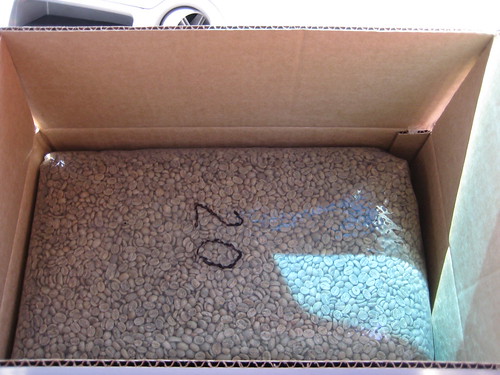I saw this photo and it reminded me to take a moment and breathe. This is a photo of some of the first Guatemalan coffees to exit Guatemala in something other than jute. We are proud to have a hand in that process and look forward to seeing more lots exit the country that way. Guatemala is such a great place for good coffees. I am told the 18th of this month, our premium Kenyan coffee arrives which is also vacuum sealed at origin. We were lucky on this one because someone else already established the demand. We were all set to have our pick flown in at what is a pretty high cost until we found out vacuum packaging was ready and of course we jumped on it.
People talk a lot about quality but if you really look at the handful of people who have pushed progressive packing, that set the bar for me. Anyone can fawn over 2 buck chuck or overpay for the right to have paid the most but I respect those who put the money into preserving the coffee. How much of that proverbial 90pt+ coffee faded on the boat over bagged in jute? Who is legit if they ignore that, stuff the green in a hot and humid warehouse, then pitch you a romantic story? There is a lot of showmanship and you have to dig deeper to feel out what's behind the bravado.
This is a fun week. Profiling and working on the big roasters. Waiting for coffees to arrive. I owe a lot to Simon Hsieh for giving us a starting point to work from. I don't disrespect the influence he has had among others.
Roasting is complicated. Imagine working three variables: drum speed, air flow, BTU(heat). Now imagine you had no base, how long would it take you to find the right drum speeds, air settings, and gas settings for one coffee? If you apply true scientific method(which almost no professional roasters do), you would only change one variable at a time and test each single variable independently.
Tedious.
Take a basic profile and then test variations with a scientific process and you can progress very quickly gathering a mountain of data quickly.
We have a special roaster which was a great burden but I really believe it will be something great. It is a 4 kilo called a direct flame but it's really a hybrid. The drum is solid cast iron with a couple thousand holes drilled in it so it's not the mesh of traditional direct flame drums. This overcomes a lot of issues in the roast inherent in traditional direct flame roasters. The profile is a combination of an air roaster with a solid drum slash direct flame. You can get explosive aroma, deep sweetness, and the acidity can be decidedly candied instead of sparkling or the more common sharpness. The air flow is amazing and patented by the way. I won't post photos but the mfg developed a manner to make the airflow fairly linear. It operates, in essence, like a camera aperture. Gone are the dorky damper style flaps which are often limited to open, half, or closed where one quarter may not really mean one quarter. The custom air flow has 10 settings of which I use about 5 during a normal roast.
Other specs: variable drum speed, gas gauge, digital bean probe with measurement to one tenth of a degree(can be ported and data logged), and an analog probe in the exhaust. All of those components are controlled on a box that is located about chest high which beats bending over to adjust/log or having a stand with cords you can trip over. The flame pilot and lighting sequence is absolutely b-spec, automated with a flame sensor, timed lighting sequence, and the gas valve has an auto shutoff sequence when it reaches the over temp alarm. The kicker is an external chaff collector which is massive and completely unheard of for a roaster this size.
There were definitely some growing pains but thankfully I had been working the baby version of this, affectionately called the Mini, for half a year previous. The profile scaled up very well so it only took a dozen roasts to get comfortable. Though, honestly, I don't think we will ever stop long enough to really get comfortable so it's all relative.
All I can say is that for the first time in months, I had one of those moments the other day where I was smiling and goofy instead of deep in problem solving mode. It's a good feeling.

